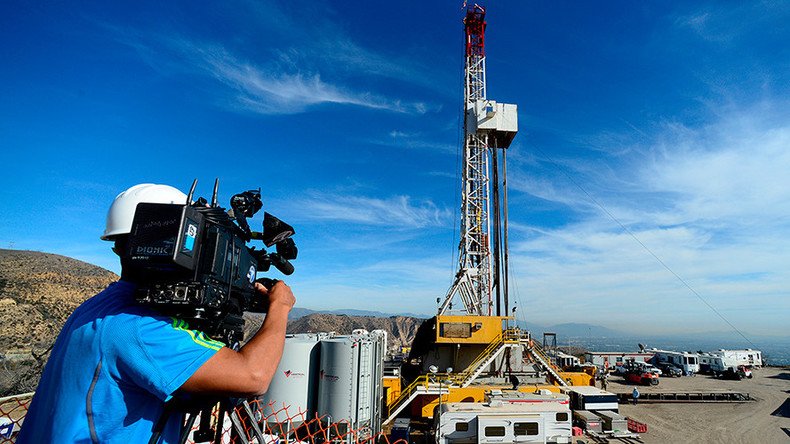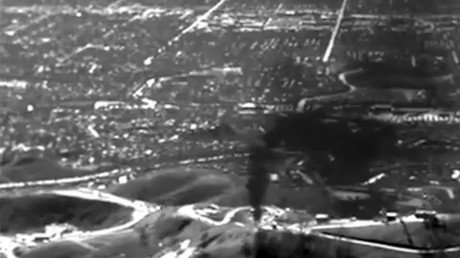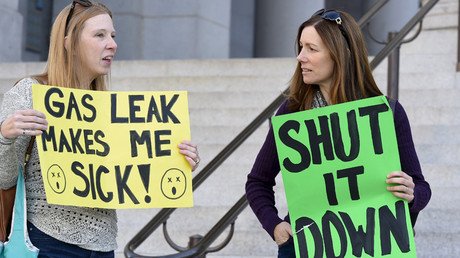California methane leak: Regulators delay 'capture and burn' vote

Air regulators in Southern California have postponed a vote to address the nearly three-month gas leak in the Porter Ranch area. A plan to capture and burn leaking gas will be examined for safety by local, state, and federal entities.
The South Coast Air Quality Management District (AQMD) delayed a vote on Saturday that would have required the Southern California Gas Co. to incinerate the leaking gas in order to offer affected residents some reprieve until a relief well can help seal off the leak coming from an underground gas storage reservoir at Aliso Canyon. Yet, at the earliest, the relief well is not expected to be completed until early next month.
The delayed incineration plan would employ a 3-foot-wide pipe to capture and burn leaking gas emissions at 8,500 feet below ground surface, according to the Los Angeles Times.
Fearing explosion, CA regulators delay decision on whether leaking methane must be burned: https://t.co/GiCq7GaU56pic.twitter.com/lKKlgw19Gh
— John Upton (@johnupton) January 17, 2016Meanwhile, the leak, first reported on October 23, has emitted enough methane gas to dislocate around 4,500 families in the northwest San Fernando Valley – at the expense of SoCal Gas – while triggering a state of emergency declaration by California Governor Jerry Brown. The well, one of more than 100 at the Aliso Canyon reservoir, was subject to two months of high-pressure pumping once the leak was discovered.
Aliso Canyon #methane leak sheds light on national problem: https://t.co/yGzCkBnAqRpic.twitter.com/91M9NafIs5
— EDF (@EnvDefenseFund) January 15, 2016The capture-and-burn plan includes requirements that SoCal Gas reduce gas in the storage reservoir, evaluate emissions, and pay for a study on the health impacts of the leak.
Early last week, the state's Public Utilities Commission (PUC) voiced concern to SoCal Gas over the capture-and-burn plan's safety, particularly its potential for a massive explosion, saying it “needs further work and analysis.”
CA methane leak currently the daily equivalent of driving 4.5 million cars. https://t.co/9sHBd9jnj8
— Bill McKibben (@billmckibben) January 14, 2016Damage to the well might allow air to mix with methane, a development that "could be catastrophic," the PUC said in a three-page letter. Local fire officials, state, federal regulators will now examine the plan's safety, according to reports. If approved, the capture-and-burn plan would extract 20 million cubic feet of natural gas from the air each day, an amount that is about half of the entire leak, according to the LA Times.
"If we can't capture that gas safely, we're not going to do that. Safety is the first priority," SoCal Gas spokesman Mike Mizrahi said, according to the Associated Press.
Why the methane from #California's gas leak is such bad news for the #climatehttps://t.co/Cig11IPEl3pic.twitter.com/iY7E3ZCrtG
— Greenpeace (@Greenpeace) January 15, 2016The plan's delay was announced on Saturday at a public meeting where Porter Ranch residents were allowed to address AQMD and SoCal Gas officials. Many concerned residents attended the meeting with signs that read "Shut. It. All. Down." Some said that they have noticed a gas-leak odor in the area for years. Residents have complained of illness, including nausea, headaches, and nosebleeds, since the leak began.
“The air district doesn't need to stall any longer because it has all the information it needs to make the right decision right now: shut down the Aliso facility once and for all,” said Porter Ranch resident Matt Pakucko, according to the LA Times.
The AQMD's board will reconvene the public hearing on Wednesday.
Calm down, everyone. The gas leak in California isn't that BLad annd it's not afeckting th air or notjing like that guffybhghhfh 🐔☃ bbb
— Patton Oswalt (@pattonoswalt) January 16, 2016SoCal Gas has apologized for the leak, but has said it "does not pose an imminent threat to public safety."
"The well is located in an isolated, mountain area more than a mile away from and more than 1,200 feet higher than the closest home or public area. Scientists agree natural gas is not toxic and that its odorant is harmless at the minute levels at which it is added to natural gas," the company said in a statement.
The breach has steadily sent 62 million cubic feet of methane gas into the air every day since October 23, according to an estimate from the Environmental Defense Fund. The organization has used thermal photography and video to visualize the leaking gas plume from the Aliso Canyon reservoir, the largest gas storage well in the western US.
Methane is about 80 times more potent as a warming agent than carbon dioxide. The leak has been called a "mini-Chernobyl" by Mike Antonovich, the Los Angeles County supervisor, referring to the 1986 explosion at the Chernobyl Nuclear Power Plant in Ukraine that is considered the worst nuclear power plant accident in history.
SoCal Gas has been accused of understating the hazards of the leak, as some have raised concerns over the level of benzene being emitted into the air. Benzene is considered a cause of cancer and leukemia by the World Health Organization and the US government. “No safe level of exposure can be recommended,” according to WHO.
Los Angeles County and Los Angeles city are involved in a civil lawsuit against SoCal Gas.














